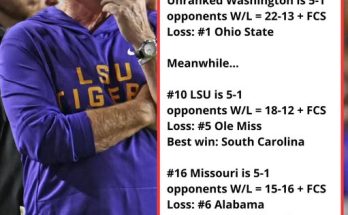What a player indeed. In a landscape where college athletics has long been defined by passion, tradition, and the pursuit of glory on the field, the latest actions of Auburn Tigers’ star wide receiver Cam Coleman remind us that the impact of student-athletes extends far beyond touchdowns and highlight reels. On Thursday, Coleman shocked the college football world not with a jaw-dropping catch or a game-winning score, but with the announcement of a philanthropic gesture that could transform lives for generations. His monumental $2.5 million donation, one of the largest public philanthropic endeavors ever undertaken by a current collegiate athlete, will fund the construction of a new multifaceted facility that promises to enrich not only Auburn University’s athletic landscape but also the surrounding community.
At a time when NIL deals and personal branding dominate the narrative around collegiate sports, Coleman’s gift has shifted the conversation from what athletes gain to what they can give back. Many athletes find themselves balancing academics, athletics, and the newfound financial opportunities of Name, Image, and Likeness. Yet few have taken the bold step Coleman has, committing such a large sum toward a legacy project that is focused not on himself but on the well-being of others. This decision paints a portrait of maturity, foresight, and responsibility, proving that college athletes are capable of reshaping the narrative about their roles in society.
For Auburn fans, Coleman’s donation is more than just a gift; it is an embodiment of the ideals that the program holds dear. Auburn has long prided itself on producing not only elite athletes but also individuals who embody the spirit of service, leadership, and community. Coleman’s action connects directly with that tradition, signaling that the lessons learned on the field—discipline, teamwork, sacrifice—extend seamlessly into life beyond the sidelines. It is a reminder that college sports are not just about what happens on Saturdays in front of roaring crowds but also about the quiet, deliberate choices that build enduring legacies.
The facility itself, which will be funded by this groundbreaking donation, is poised to become a hub for innovation, training, and community development. Early reports suggest it will be multifaceted, integrating state-of-the-art athletic resources with spaces that benefit both student-athletes and the larger Auburn community. From academic support centers to health and wellness areas, and from leadership training rooms to community engagement spaces, the facility is expected to embody the holistic vision of development that modern universities strive to achieve. Rather than limiting the benefit to those wearing Auburn jerseys, the facility will create an inclusive environment where future generations of students, athletes, and residents can find resources to thrive.
Coleman’s gift is transformative because it redefines what we expect from collegiate athletes in this era. For years, the debate around college sports has centered on whether athletes should receive compensation, how NIL agreements should be regulated, and whether the system adequately values the athletes’ contributions. What Coleman has shown is that with financial opportunity comes the chance for profound generosity. He has turned the spotlight away from the question of fairness and toward the potential for impact. His action poses an unspoken challenge to others in his position: What will you do with your platform? How can you use your influence and resources to create something lasting?
In many ways, Coleman’s decision to make this donation echoes the actions of professional athletes who have used their fame and fortunes to fund schools, build community centers, or support scholarships. LeBron James, for instance, has built schools and community programs that have transformed Akron, Ohio. Similarly, players like J.J. Watt and Serena Williams have used their wealth to uplift communities. But what makes Coleman’s donation extraordinary is that it comes at a time when most athletes his age are still figuring out how to balance their new NIL incomes with their immediate needs. For him to commit such a large amount of money while still in college is almost unheard of. It is a decision that speaks not only to his character but also to the culture Auburn has cultivated around him.
The reverberations of this donation will be felt on multiple levels. For Auburn, it is a statement of pride, signaling to recruits, alumni, and fans alike that the program is built on more than wins and losses. It demonstrates to future athletes that Auburn fosters leaders who think beyond themselves. For the wider SEC and college football world, Coleman’s gift may inspire other athletes to consider how their financial opportunities can be invested back into their schools or communities. And for the broader landscape of philanthropy, it highlights the growing role that younger generations are playing in reshaping the way wealth and resources are distributed.
Coleman’s generosity also highlights the evolution of athlete activism. In decades past, college athletes often had little to no platform beyond their sport. Their influence was limited to their performances on the field, and their impact was largely measured in wins, statistics, or championships. Today, however, the landscape is different. Athletes like Coleman are demonstrating that their voices, choices, and resources can influence culture in profound ways. His gift speaks not only to his personal values but also to the shifting expectations of what it means to be a student-athlete in the 21st century. The ability to align financial power with social responsibility has become one of the most powerful ways athletes can cement their legacies, and Coleman has done just that.
Of course, the symbolism of this donation cannot be overlooked. Football, particularly in the South, is more than a sport; it is a cultural pillar. Auburn football has brought people together across generations, uniting fans under the orange and blue in celebration of tradition and pride. By choosing to give back through the sport that elevated him, Coleman has tapped into that cultural heartbeat, ensuring that his contribution resonates with the spirit of Auburn itself. His donation is not just about bricks and mortar; it is about strengthening the bond between the team, the university, and the wider community.
Critics may point out that $2.5 million is a staggering sum for someone so young to part with, and questions may arise about whether it is wise for an athlete with an uncertain professional future to commit such funds. Yet Coleman’s boldness is precisely what makes this gesture so inspiring. It reflects a willingness to prioritize long-term impact over short-term comfort. It reveals confidence in his future and a deep sense of responsibility to those who supported him along the way. In a world where many choose to wait until they’ve “made it” to give back, Coleman’s choice to act now sets him apart as someone who understands that timing can be just as important as generosity.
Beyond Auburn, Coleman’s donation sets a precedent for the broader college athletics community. It introduces a new paradigm in which student-athletes are not simply consumers of opportunity but also creators of it. They are not merely beneficiaries of scholarships and fan support but active contributors to the growth of their institutions. Coleman’s action forces us to rethink the old narrative of athletes as transient figures in college life. Instead, it suggests they can be long-term builders, leaving behind tangible legacies that endure long after they’ve graduated or moved on to professional careers.
For younger athletes watching Coleman’s journey, this moment will serve as a teaching point. It will show them that success is not only measured in personal achievements but also in how one uses those achievements to uplift others. For Auburn fans, it will forever connect Coleman’s name not only with spectacular plays on the field but also with a transformative act of generosity. His jersey will represent more than just athletic excellence; it will symbolize selflessness and vision. And for the broader public, it will be a story of how even in an era often dominated by discussions of self-interest, there are still individuals willing to place the collective good above their own.
In the years to come, as Auburn’s new facility rises from the ground and begins to serve the community, Coleman’s contribution will take on an even deeper meaning. Each student who finds support in its academic center, each athlete who trains in its modernized facilities, and each community member who benefits from its resources will be a testament to his vision. The building will not just be a structure; it will be a symbol of the enduring power of generosity, a reminder that legacies are built not only in record books but in the lives touched along the way.
Ultimately, Coleman’s $2.5 million gift represents the best of what college athletics can be. It blends passion with purpose, opportunity with obligation, and personal success with collective uplift. It demonstrates that even in a world where college athletes face immense pressure to perform, they can still find space to consider the needs of others. Coleman has shown that greatness is not defined by statistics alone but by the courage to invest in a vision larger than oneself.
So when Auburn fans chant his name in the stadium or recall his accomplishments years from now, they will not only remember the catches, the touchdowns, or the victories. They will also remember this moment—when one of their own looked beyond the field and decided to make a difference that will last for generations. What a player, indeed.



